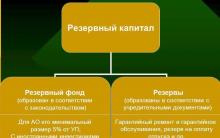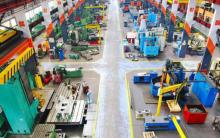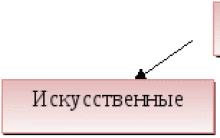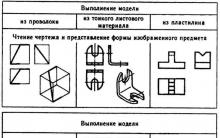Such costs, in turn, can be distributed among general production and general business expenses.
Methods for distributing general production and general business expenses
The presence of the specifics of the production process for each individual organization does not imply a universal and strictly fixed division of costs into general economic and general production. Each company independently chooses methods for distributing overhead and general business expenses. The principle of correlating expenses in accounting to one category or another is enshrined in the accounting policy. However, there is a certain general approach that all companies without exception should adhere to. General production expenses include costs in the usual line of business that arise for an enterprise in connection with the need to maintain main and auxiliary production facilities. General business expenses include costs associated with managing an organization that are not directly related to the production process. However, they also participate in determining the cost of goods or services produced.
More specifically, general production expenses are the costs of maintaining machinery and equipment, deductions for depreciation and repair costs of fixed assets, costs of various utilities, the purchase of which is necessary as part of the production process, rent of premises, machinery, equipment and others objects used in production, salaries of technical personnel, and so on. In short, these are all those costs that a company can accurately correlate with the production of a specific product.
General business expenses include the costs of maintaining administrative and management personnel not related to the production process, depreciation and other costs of maintaining the operating system and rental and maintenance of premises related specifically to this company structure, costs of paying for information, auditing, consulting services, etc. administrative expenses similar in purpose. Such costs are important for the functioning of the company as a whole, but they cannot be attributed to a specific production process.
How exactly are general production and general business expenses distributed in accounting? Let's try to figure it out.
Accounting for overhead costs
To reflect costs that are directly related to the production of any product, the Chart of Accounts uses account 25 “General production expenses”. Postings on it are reflected taking into account information about the costs of servicing the main and auxiliary production facilities of the organization. The debit of this account accumulates data on the composition of costs, which are also reflected in the credit of accounts payable to personnel, accounting for inventory, rental deductions, etc. Simply put, analytical accounting for account 25 can be carried out in the context of various expense items. If the company has many divisions, workshops or similar separate structures, then it is also advisable to carry out analytics on account 25 “General production expenses” taking this factor into account, using additional division. General production expenses are written off by posting from the credit of account 25 to the debit of accounts 20 “Main production”, 23 “Auxiliary production”, 29 “Service production and facilities”. This entry is made at the end of the month, thus the accumulated cost data on account 25 is reset to zero.
An example of reflecting general business expenses and postings:
|
Materials written off for general production purposes |
|
|
Accrued depreciation of general production equipment |
|
|
Wages paid to employees involved in production |
|
|
Insurance premiums are calculated on the wages of workers involved in production. |
|
|
Works/services of third party suppliers purchased for general production purposes are accepted |
|
|
General production expenses were written off as expenses of the main production |
Accounting for general business expenses
To summarize information about expenses for management needs not directly related to the production process, the “General business expenses” account is intended. In contrast to the distribution of general production expenses, general business expenses on account 26 in most cases are not divided, from the point of view of analytical accounting, among the various structures of the organization. After all, as a rule, a company has only one administrative and managerial division, which is responsible for overseeing its work as a whole. However, if accounting tasks require it, the organization can maintain additional parameters for data reflection.
At the same time, the reflection of the costs themselves in various areas (wages, materials, rent, depreciation, etc.) will be similar to the registration of entries in account 25 “General production expenses”. That is, the postings in this case will be formed exactly according to the same principle: from the credit of accounts for inventory accounting, settlements with employees for wages, settlements with other organizations (individuals) to the debit of account 26. At the end of the month, as well as general production, general business expenses are written off by posting to the debit of accounts 20, 23 or 29.
If we are talking about companies that do not carry out production activities, but, say, are engaged in the provision of services, then such organizations can use account 26 to summarize information about expenses for all their activities. In this case, the expenses reflected on it will be written off at the end of the month not through account 20, but immediately to the debit of account 90 “Sales”.
At production enterprises, among the cost accounts, the 25th is intended to summarize information on expenses for auxiliary and main production.
Classification of enterprise costs
All expenses that make up the total costs of the enterprise and form the total cost of production are divided into 2 types:
- Direct are directly related to product output. These include costs for purchased raw materials, materials, employee wages and others related to specific products and work.
- Indirect costs are not directly attributable to specific types of products or services. Such costs are distributed among the cost of manufactured products (services provided).
The composition of direct expenses is determined by the taxpayer independently in accordance with the established accounting policy of the organization. Refers to costs in the current period as products are sold or services are provided.
Indirect costs are subsequently distributed between the main, auxiliary and service industries, depending on the specifics of the enterprise's activities.
Account 25 in accounting: its purpose
General information on servicing the main and auxiliary production is collected on account 25. Based on the results of the reporting period, the account is closed.
Account 25 can be called a collective and distribution account. Includes expenses for their subsequent redistribution. The account is actively used in manufacturing organizations engaged in production.
The list of costs that are collected on account 25 is quite extensive. Depends on the direction of production activity. Typically this includes the costs of wages, electricity and other utility bills, and payment for other services.
Production costs 25 accounts
| Expenses | Examples of costs | Sources of costs |
| General production | Employee salaries, management expenses, travel allowances, contributions to extra-budgetary funds | 70, 69, 76 |
| Production | Salaries of the management staff, maintenance and repair of buildings, insurance transfers | 70, 69, 02, 10, 60 |
| Non-productive | Production losses, damage to goods and products | 94 |
Under some circumstances, the use of 25 accounts is abandoned. This happens in situations where there are few types of products. Costs can be collected immediately directly on account 20 and 23.
However, in most cases, the formation of indirect costs is inevitable. In addition, it is not always economically profitable to take into account only direct expenses, thereby overestimating the tax base of the enterprise. Large enterprises cannot avoid the presence of indirect costs in accounting.
Definition of account 25 in accounting
Indirect costs 25 accounts do not directly participate in the formation of the final cost of production. Written off by distribution into 20, 23 or 29 accounts. The principles and methods of these actions should be fixed in the accounting policies.
The sources of cost formation in account 25 are accrued wages, contributions to extra-budgetary funds, depreciation of equipment, supplier services, travel expenses and other costs.
Example. The salary of the management staff for the quarter amounted to 116,000 rubles, contributions to funds - 35,264 rubles. Costs for electricity and other utility bills amounted to 187,000 rubles. Depreciation of the industrial building amounted to 27,500 rubles. Based on the results, the following entries will be generated in accounting:
- Dt 25 - Kt 70 - 116,000 rubles - salary of management personnel.
- Dt 25 - Kt 69 - 35,264 rubles - insurance premiums accrued.
- Dt 25 - Kt 60 - 187,000 rubles - invoice received from utility providers.
- Dt 25 - Kt 02 - 27,500 rubles - depreciation of the building is written off as general production expenses.
- Dt 20 - Kt 25 - 365,754 rubles - general production expenses involved in the formation of the cost of manufactured products are written off.
Composition of expenses in tax accounting
To calculate profit, both direct and indirect costs are taken into account if the current accounting policy allows the use of the accrual method.
Indirect expenses, including those accumulated on account 25, are written off in full, reducing the profit from income received, sales of goods and services.
The taxpayer has the right to offset direct expenses not in full, but only in part of the costs included in the cost of products sold. That is, expenses that can be attributed to work in progress should not be attributed to the remaining products in the warehouse as expenses of the current period.
The requirements of the Tax Code do not contain direct instructions regarding the classification of direct and indirect costs. However, the cost distribution process itself must be economically justified. Indirect ones, accumulating on account 25, should be formed only if it is not possible to attribute them directly to any type of product.
Traditionally, direct costs include the following:
- material costs aimed at purchasing raw materials for production;
- purchase of components and other semi-finished products;
- remuneration of employees directly involved in the production process, accrued contributions to extra-budgetary funds in favor of the specified personnel;
- depreciation of property related to the production process.
The list of expenses that are classified as direct is not closed. The organization has the right to create a more detailed list of costs independently.
In order to avoid subsequent claims from control authorities, it makes sense to prescribe economically sound principles in the current accounting policy of the enterprise. In this case, inspectors will have no reason to recognize indirect costs as direct, thereby increasing the tax base.
Indirect costs are directly involved in reducing the profit level of the enterprise, reducing the costs of the unshipped part of the product or work in progress.
However, the desire to classify as many costs as possible as indirect must be exercised with caution. In fact, this right to accept all costs as indirect is given only to organizations providing services.
If the enterprise had no income in the reporting period, it does not have the right to take into account the indirect expenses that arose when determining the tax base, according to the tax authorities. If the management of an organization makes a different decision, it may entail the need to defend its point of view in court.
Production of products is always associated with certain costs, which subsequently form the cost value. General production expenses combine the amounts necessary to maintain the main and auxiliary production workshops. Costs not directly related to the manufacture of products are classified as general business expenses and are accounted for separately.
Definition
Manufacturing overhead costs are costs directly related to production activities. The main distinguishing feature from direct costs of manufacturing products is that the amounts cannot be attributed to a specific type of product. General production expenses may include costs for:
- depreciation deductions;
- equipment maintenance;
- payment for utility services;
- rent of industrial premises;
- wages for workers involved in the service process;
- other expenses.
Although costs are not directly related to any type of product, they must be taken into account when calculating production costs.
The concept of general expenses
The activities of any enterprise are necessarily connected with the functioning of its various departments. A production workshop cannot operate on its own without management and control employees. The products must then be stored and sold, which requires other personnel and premises. All this leads to the formation of costs that seem to be far from the production process, which are combined into the group of general business expenses.
They may include amounts necessary for:
- covering administrative and management expenses;
- remuneration for employees employed outside production;
- depreciation and repair of general purpose fixed assets;
- payment for rent of non-production premises;
- covering other expenses of a similar nature.
General business expenses are also written off as the cost of manufactured products in accordance with the rules of the enterprise's accounting policy.
Characteristics of overhead costs
General production and general business expenses are combined into a group of indirect costs that arise in the course of the enterprise's activities. It is difficult to trace the ratio of their amount to types of products and production time, so they are written off by the method of allocating costs in proportion to a given indicator.
General production and general business expenses are taken into account, highlighting separate cost items and departments (shops). This allows you to control the distribution of funds and identify the most expensive objects to maintain and manufacture.
Overhead costs in accounting data
General and general production expenses in total terms are reflected in synthetic accounts 25 and 26. Both accounts do not have a balance at the end of the month, since they serve to collect and distribute the costs of main production. The amounts are written off to account 20, making entries Dt 20 Kt 25/26. Some enterprises (for example, those providing intermediary services) account for all administrative and general business expenses on account 26, without using account 20.

Analytical accounting is also kept for accounts 25 and 26. Sub-accounts are opened for each workshop, as well as for individual items of general business expenses. When filling out, the accountant is based on data from primary documentation and other forms of accounting registers developed by the enterprise. Additionally, statements No. 12 and 15 are maintained to account for general production and general business expenses.
Typical entries for the debit of accounts 25, 26
Accounting for overhead costs includes collecting information about cost items for maintenance, servicing and fulfilling the needs of main and auxiliary production. Using account 26 pursues the same goals, only the amounts of administrative and management expenses are recorded. During a certain period, the necessary information is collected in the debit of accounts 25 and 26.

In this case, the following postings Dt 25/26 can be made:
- Kt 02, 05 – depreciation of fixed assets and intangible assets has been accrued;
- Kt 70 – wages accrued to general production (administrative) personnel;
- Kt 69 – social benefits accrued. payments to employees involved in servicing workshops (management employees);
- Kt 76 – general production (general business) expenses include payment of utility bills;
- Kt 10 – materials were sent for the maintenance of production (administrative) facilities.

In addition to the account assignments discussed, others can be used. The main thing is not to violate the principle of double entry and follow the active account rule: credit in debit, write-off in credit.
Loan transactions: write-off of overhead costs
The instructions for using the standard chart of accounts say that collective synthetic accounts 25 and 26 must be closed at the end of the month. This requirement means that all debit amounts are charged to account 20 (or 90 for general expenses). The accountant will record entries like:
- DT “Main production” CT “Overhead production expenses” – the amounts of general production expenses incurred for the needs of the main production shops are written off;
- Dt “Service production” Kt “Overhead production costs” – the amounts of overhead costs for remuneration of personnel of service production are attributed;

- DT “Auxiliary production” CT “General production expenses” – expenses for utility bills for auxiliary production facilities are written off;
- DT “Main production” CT “General business expenses” – general business expenses were included in the actual production cost;
- Dt “Cost of production” Ct “General expenses” - the amounts of administrative and managerial costs are written off to the cost of production.
Depending on which account the data from the debit turnover of general business expenses is credited to, the full or production cost of the products is formed.
Production cost
Costs arising in connection with the maintenance or maintenance of production facilities can be attributed to the final result in proportion to the amount specified by the accounting policy. The distribution of overhead costs aims to calculate the cost per unit of production at the exit from the workshop, taking into account all the costs of the industrial cycle.

The distribution of general production and general business expenses when using this method occurs in different ways: from account 25 the amounts are written off to the 20th account, and from 26 to 90. Thus, administrative, managerial and other overhead expenses in terms of general business expenses are not included in the production cost, but relate directly to the financial result.
This is one of the methods that can be applied in an enterprise. Production cost indicators allow you to analyze the profitability of a particular workshop and regulate the amount of costs for the production of certain types of products.
Cost and taxation
In order not to create additional registers for tax accounting purposes, it is better to account for overhead costs at the full production cost. The method involves writing off to the debit of account 20 both general production and general business expenses. The accountant’s choice of a method for attributing indirect costs to the cost of products should be based primarily on the provisions of the enterprise’s accounting policy.

General production expenses (account 25) and expenses for general business needs, together with data from account 20, make up the bulk of the cost of manufactured products. The data is used both for the purposes of accounting and analysis of the financial activities of the enterprise, and for tax service data.
Account 25 (overhead expenses)
We talked about the features and composition of overhead costs in. We will tell you in this material how accounting of overhead costs is kept and how overhead costs are distributed.
Account 25 “General production expenses”
Let us recall that general production expenses are the costs of servicing the main and auxiliary production of the organization.
General production expenses are accounted for on account 25 “General production expenses” (Order of the Ministry of Finance dated October 31, 2000 No. 94n).
General production costs are collected in the debit of account 25 from the credit of accounts for accounting for inventories, settlements with employees for wages, etc. In fact, accounting for general production and general business expenses in terms of reflection in the debit of accounts 25 and 26 “General business expenses” is similar. The difference is only in the composition of costs, which can be included in the composition of general production or general economic costs of the organization.
The most typical example of overhead costs is the costs of a workshop in which several types of products are produced.
Here are the most typical transactions for general production expenses:
| Operation | Account debit | Account credit |
|---|---|---|
| Accrued depreciation of general production equipment | 25 | 02 “Depreciation of fixed assets” |
| Materials written off for general production purposes | 25 | 10 "Materials" |
| Wages accrued to general production employees | 25 | 70 “Settlements with personnel for wages” |
| Insurance premiums have been calculated for the wages of general production employees. | 25 | 69 “Calculations for social insurance and security” |
| Reflected expenses for insurance of general production property | 25 | 76 “Settlements with various debtors and creditors” |
| Provided third-party general production services | 25 | 60 “Settlements with suppliers and contractors” |
Write-off of general production expenses
Since there should be no balance on account 25 at the end of the month, at the end of the month overhead expenses are written off by posting:
Debit account 20 “Main production” - Credit account 25
Similarly, general production costs can be written off as part of the costs of auxiliary production or service industries and farms.
So, when writing off general production expenses, the posting may be as follows:
Debit account 23 “Auxiliary production” - Credit account 25
And if general production expenses are written off for the costs of service facilities, the posting will be as follows:
Debit of account 29 “Service production and facilities” - Credit of account 25
How are overhead costs distributed?
The organization determines the methods for distributing general production and general business expenses independently based on the characteristics of its activities and the procedure established in.
In general, to determine the distribution coefficient of overhead costs, the formula can be presented as follows:
K OPR = OPR / B,where K OPR is the coefficient of distribution of overhead costs;
OPR - the amount of general production expenses for the month;
B - base for distribution of general production costs.
The specified coefficient can show how many rubles of overhead costs are per 1 ruble of the distribution base. This coefficient can also be presented as a % by multiplying the resulting indicator by 100.
We gave an example of the distribution of indirect expenses reflected in account 25.
However, the basis for the distribution of general production costs may be different. For example, the cost of basic raw materials and supplies, the number of employees, the cost of fixed assets and other indicators.
When determining a particular method for distributing overhead costs, the basis is chosen that most closely shows the relationship between overhead costs and the cost of the final product.
Account 25 “General production expenses” is intended to summarize information on the costs of servicing the main and auxiliary production of the organization. In particular, the following expenses may be reflected on this account: for the maintenance and operation of machinery and equipment; depreciation charges and costs for repairs of fixed assets and other property used in production; expenses for insurance of the specified property; costs for heating, lighting and maintenance of premises; rent for premises, machinery, equipment, etc., used in production; remuneration of workers engaged in production maintenance; other expenses similar in purpose.General production expenses are reflected in account 25 “Overall production expenses” from the credit of accounts for inventory, settlements with employees for wages, etc. Expenses recorded in account 25 “Overall production expenses” are written off to the debit of accounts 20 “Main production”, 23 “Auxiliary production", 29 "Servicing industries and farms".
Analytical accounting for account 25 “General production expenses” is carried out for individual divisions of the organization and expense items.
Account 25 “General production expenses” appeared due to the fact that a workshop can produce not only one, but several types of products, so the problem arises of how to include such general (indirect) expenses in the cost of finished products. During the reporting period, these costs are collected on temporary transit account 25 “General production costs”, and at the end of the reporting period, when calculating the full cost of finished products, the problem arises of including these costs in specific types of products, therefore this account belongs to the group of collecting and distribution accounts . And depending on how the accountant distributes these costs between types of manufactured products according to randomly selected bases, he will receive the corresponding cost value.
An important addition to the characteristics of account 25 “General production expenses” is that it can reflect the costs of repairing not only fixed assets, but also “other property”, in particular tools and business equipment, regardless of which account will be taken into account last.
Account 25 “General production expenses” reflects indirect costs for servicing main and auxiliary production when two or more types of products are produced. These include costs for the maintenance and operation of machinery and equipment, production management and maintenance, etc.
The amount of these costs in most cases depends on the volume of production. So, all these expenses during the month are collected in the debit of account 25 “General production expenses”, and at the end of the month their total amount is distributed between the types of products produced and written off, depending on the type of production, either to account 20 “Main production”, or to account 23 “Auxiliary production”, or to account 29 “Service production and farms”. Thus, on the first day of each month, account 25 “General production expenses” has no balance.
Manufacturing overhead costs can be allocated among product types in different ways. If the calculation is carried out not by the names of manufactured products, but by responsibility centers, then there is no need to distribute overhead costs by type of finished product.
When calculating workshop costs, it is advisable to include general production costs in the costs reflected on account 20 “Main production”.
The distribution of overhead costs by type (name) of product or by responsibility center involves determining the distribution base. Most often, the distribution is carried out in proportion to the wages of workers in the main production. This decision is motivated by theoretical and practical reasons.
In the first case, we are talking about the labor theory of value, according to which value is created only by the abstract labor of direct producers, i.e. workers. Devout Marxist A.A. Bogdanov believed that it was necessary to take into account all the labor of those involved in production. In the second, they proceed from the fact that such a solution is technically very simple to implement. However, this reveals a paradox that K. Marx encountered more than a hundred years ago: the higher the level of mechanization and automation, the smaller the share of indirect costs falls on such a “center of responsibility.” In fact, the more machines, the higher the share of depreciation expenses, but their main amount is written off to production areas in which there is either no depreciation, or almost
No. This suited some managers, as it allowed them to prove the high efficiency of the use of machinery and equipment and note that the lack of mechanization makes production unprofitable. However, this is just an accounting trick. The difficulty is that allocating costs to any basis will always be a trick.











Presentation on the topic "special theory of relativity"
Why is Rosneft buying TNK-BP Which oil and gas company does TNK own?
Blog of Anatoly Shariy 25.08. How blogger Anatoly Shariy fired the Minister of Information of Ukraine. Conflicts with the Ministry of Internal Affairs
Best International Art Gallery
Chinese Pilot Jao Da